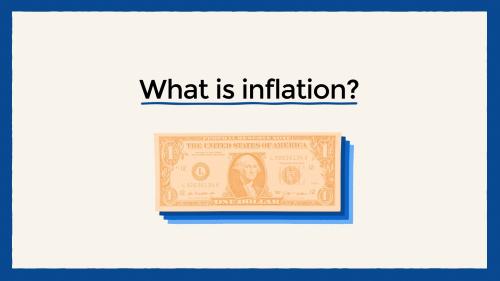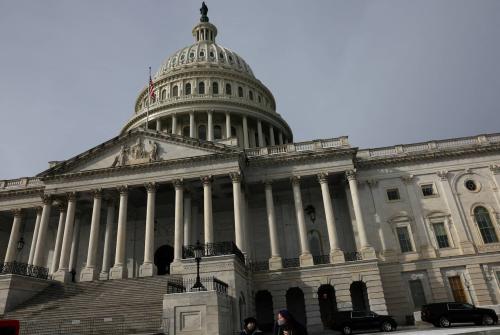Chairman Brady, Vice Chairman Klobuchar, and members of the Committee:
This hearing is called: “Flirting with Disaster: Solving the Debt Crisis” I would like to suggest an alternative title: “Avoiding Disaster: Growing the Economy and Stabilizing the Debt.” I make this suggestion because I believe strongly that future American prosperity requires bipartisan cooperation to achieve two goals at once:
- Faster economic growth that will create more jobs and bring the unemployment rate steadily down at least to the 5-6 percent range.
- A sustainable long-run budget plan that will halt the projected rise in the debt/GDP ratio and put it on a downward trajectory by the end of the decade.
The two goals reinforce each other and neither can be achieved without the other. Weak economic growth—or worse, sliding back into recession—will reduce revenues and make it much harder to reduce or even stabilize the ratio of debt to GDP. But the prospect of debt growing faster than the economy for the foreseeable future reduces consumer and investor confidence, raises a serious threat of high future interest rates and unmanageable federal debt service, and reduces likely American prosperity and world influence.
Stabilizing and reducing future debt does not require immediate austerity—on the contrary, excessive budgetary austerity in a still-slow recovery undermines both goals—but it does require a firm plan enacted soon to halt the rising debt/GDP ratio and reduce it over coming decades. Financial markets will not provide advance warning of when such a plan is required to avert negative market reactions. At present the United States appears to have unlimited access to world markets at low interest rates But this market confidence could evaporate quickly, possibly because of developments elsewhere around the world and beyond our control. The sooner we enact such a plan, the better the prospects for our economy. There is no valid argument for delay.
Putting the budget on a sustainable path and reducing the debt/GDP ratio will require bipartisan agreement on entitlement reform that slows the growth of health care spending and puts Social Security on a firm foundation for future retirees. It will also require raising additional revenue through comprehensive tax reform. I have spent much of the last several years participating in two high-profile bipartisan groups that crafted plans to grow the economy and stabilize the debt—the Simpson-Bowles Commission and the Domenici-Rivlin Task Force. That experience convinced me that bipartisan problemsolving is possible when participants are willing to confront facts objectively, listen to each other, and seek common ground. An updated version of Domenici-Rivlin is attached (For the attachment, download the testimony. -Ed.).
Although detailed recommendations of the two groups differed, each involved three elements: (1) restraining discretionary spending; (2) reducing the growth of Medicare, Medicaid and stabilizing Social Security: and (3) comprehensive tax reform to cut spending in the tax code and raise additional revenue. Indeed, the arithmetic of the problem makes all three elements necessary. More than enough discretionary spending restraint has already been accomplished. The task remaining is to find agreement on an acceptable set of entitlement and tax reforms.
Why Sequestration is Bad Policy and Should be Replaced
Sequestration is a mindless across-the-board cut designed to be such bad policy that it would never happen, and they should not be continued. Cutting discretionary spending will add to the restraining effect that the declining federal deficit is already having on the still-slow recovery, will reduce job creation, and will possibly even trigger a new recession. Domestic discretionary spending has already been reduced by more than the two bipartisan groups recommended and is scheduled to fall to historic lows. Such low levels of domestic discretionary spending endanger the government’s ability to perform essential functions that the public wants and needs. Indeed, higher investment in science, education, and modern infrastructure is needed to foster future productivity and job creation. While savings in defense can be made over time, they should result from serious planning, not meat-ax proportional cuts regardless of priorities. Since discretionary spending is not a driver of future deficits, cutting it contributes next to nothing to slowing the projected increases in spending that will push the debt/GDP ratio upward over the next several decades. Sequestration weakens both the economy and the government’s ability to do its job. It should be replaced by gradually phased in tax and entitlement reforms that will stabilize the debt. I am concerned that Chairman Ryan’s budget blueprint released on Tuesday continues to target nondefense discretionary spending, cutting it substantially more than the current sequester.
Why Entitlement Reforms are Necessary Now
Over the coming decades federal spending is projected to increase faster than the economy can grow, because a tsunami of older citizens are reaching retirement age and living longer than their predecessors, and spending for health care, disproportionately consumed by seniors, is likely to rise faster than other spending. This combination of demographics and health spending growth makes Medicare, Medicaid and Social Security drivers of unsustainable federal spending in future years. Social Security should be the easiest to reform, because it involves only money—without the complexity of health care delivery—and requires fairly minor, well understood tweaks in benefits and revenue to regain fully funded status. Social Security is an extremely successful program, which keeps millions of seniors from destitution in old age. Workers now in the labor force need to know that Social Security will be there for them when they retire or if they become disabled and that they can plan their retirement around it. The Domenici-Rivlin Task Force recommended indexing benefits to longevity (rather than further increasing the age of full retirement beyond 67); adding a bend point in computing initial benefits to reduce payments to high income people, switching to a chained CPI for indexing benefits, while protecting the lowest income and most aged recipients; and raising the cap on wages faster than under current law. Taken together, the Domenici-Rivlin Social Security recommendations increased benefits for low-income seniors while reducing those for affluent beneficiaries in order to achieve solvency.
Enactment of such a bipartisan package now would reassure current workers, demonstrate that our democracy works to solve problems before they reach crisis proportions, and contribute to stabilizing the debt. Fixing Social Security would send a strong signal to the financial markets that the nation was addressing its long-term budget problem, and, because its effects would be felt in future years, it would not threaten the current economic recovery.
Some have suggesting waiting until the Social Security Trust Fund runs out of money around 2033 before instituting reforms. This would be shortsighted and irresponsible. Workers who will be retiring in 2033 are already in their mid-forties. We owe it to them to fix Social Security now, so that they can plan their retirement with the confidence that their Social Security benefits will be there. This motivation for early action is even more important than the modest contribution that a Social Security fix will make to stabilizing the debt.
Medicare raises more complex issues than Social Security, but bipartisan compromise to slow Medicare growth without depriving seniors of needed health care is also possible. Indeed, sensible reforms of the Medicare reimbursement regime could lead the way to slowing the unsustainable growth of spending in the whole healthcare sector, relieving pressure on state, local, business, and family budgets¡Xnot just federal programs.
American health care is expensive compared to that in other developed nations and its quality is uneven. Part of the reason is that so much health care is compensated on a feefor- service basis, which encourages providers to deliver more services, but does not reward quality, efficiency, or positive health outcomes. Medicare is the most important payer of health providers. It should be possible to shift the Medicare reimbursement regime toward bundled payments for episodes of care, reimbursement of Accountable Care Organizations, and capitated payments to integrated health systems—all designed to reward delivery of effective care, meeting quality standards, and keeping beneficiaries healthy.
There are two possible approaches to improving the performance of health providers along these lines. One is to change incentives in traditional Medicare by regulation. The other is to foster competition among health plans on a regulated exchange or market place. In the original Domenici-Rivlin plan we recommended doing both¡Ximproving traditional Medicare by regulation, but also introducing the option of competition among integrated health plans in a premium support model. Subsequent analysis has suggested that it may be possible to introduce the competitive element more smoothly by ensuring that Medicare Advantage plans compete in a more transparent market place with effective incentives to improve health outcomes and lower costs. The recent slowing of healthcare spending suggests that it may be possible to keep the increase in spending close to the rate of growth of GDP without enforcing a cap.
Changing health care reimbursement and delivery practice will take time. That is why it must start soon if it is to make the necessary future contribution to stabilizing and eventually reducing the debt/GDP ratio.
Why Tax Reform Must Raise Additional Revenue
Even extremely successful efforts to deliver health care more efficiently and slow the growth of health spending will not make it possible to absorb the coming avalanche of seniors without additional revenues. Benefits for older people are already crowding out investment in knowledge and skills of young people and modernization of infrastructure needed to increase future productivity.
Our tax code contains enormous amounts of spending that is poorly designed for its ostensible purpose, disproportionately benefits upper-income people, and narrows the tax base. Reducing spending in the tax code could raise additional revenue at lower rates and make the tax system more progressive at the same time. Both Simpson-Bowles and Domenici-Rivlin recommended drastic comprehensive reform of both the individual and corporate income taxes to broaden the base and lower the rates.
The Domenici-Rivlin plan did away with almost all deductions, exclusions and other special provisions. It had two individual income tax rates—15 and 28 percent—gradually phased out the exclusion of employer-paid health insurance from taxable income, taxed capital and earned income at the same rates, converted the home mortgage and charitable deductions to credits at the 15 percent rate, and retained earned income and child credits. The result was a fairer, simpler, more pro-growth tax system that increased progressivity and raised more revenue. Such a drastic revamping of our current code would have multiple opponents, but might be easier to accomplish than a more incremental approach—which could have as many losers but no winners, without nearly as much of the potential benefit for the economy.
Importance of Both Growth and Debt Stabilization
Those of us who advocate near-term action to curb future debt increases have been called “debt scolds” and “deficit hawks.” We have been unfairly accused of favoring immediate austerity and not understanding the need for accelerating job growth and improving productivity. But pursuing the double goal of growth and debt stabilization is possible, provided we get the timing right. We should not have austerity now, but we should take immediate steps to slow the growth of entitlement spending in the future and raise more revenue through a more progressive and pro-growth tax system.



Commentary
TestimonyGrowing the Economy and Stabilizing the Debt
March 14, 2013